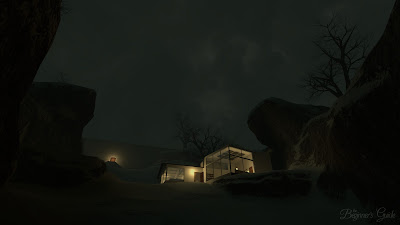Two years after the retail release of The Stanley Parable, Davey Wreden released his follow-up, The Beginner’s Guide, which I had purchased along with its soundtrack. I remembered that I liked it at the time that I played it, but had never reviewed it for whatever reason. Right after I had replayed The Stanley Parable, however, I gave this game another shot to see if my opinion on it had changed. Though I still appreciated its ambition and the point of its message after five years, I’m not sure that I thoroughly enjoyed it as much as I once did.
In The Beginner’s Guide, Davey Wreden guides the player via voiced narration through a collection of short games created by his friend, “Coda” between 2008 and 2011 while providing his own analysis and commentary in an effort to show what Coda was like. In doing so, Davey hopes he can figure out why Coda suddenly stopped developing games altogether and vanished.
Compared to its predecessor, The Stanley Parable, this game’s storytelling is much more linear and far more serious. As Davey continues through Coda’s portfolio, the narration suggests some sort of arc where Coda grows more distant and insular from some form of depression brought on by the game development process. The ending also leaves a powerful impact, as Coda’s alleged final work both exposes Davey’s true intentions and casts Coda’s supposed arc in a new light, with the player now doubting both Davey’s and their own interpretation of events. It helps that Davey shows good emotional range as a narrator, especially his convincing feelings at the end.
In spite of how powerful the ending is, if you have any knowledge of the realities of game development, the final twist loses some of its impact, as Coda’s final act would make less sense. Also, it’s quite ironic that despite the message that you shouldn’t read too deeply into someone’s work, the game itself is open to interpretation, both about its characters and the relationship between player and developer.
 |
| Davey guides the player through multiple games. |
As with The Stanley Parable, this game has all the traditional trappings of a “walking simulator”, as the player walks around the environment and interacts with objects while listening to narration. However, the format feels unique, as it’s a journey through several smaller games, each with their own instructions, stories, goals and sound design. Some are also modified by Davey for demonstration purposes, which actually becomes more of a plot point later on. Though I appreciate how the story and gameplay tied in pretty well with each other, it suffers from one big issue that its contemporaries typically suffer, namely a lack of replay value. Once you finish, there’s almost no real incentive to go back through it again, though now you can return to a specific chapter and choose to play without Davey’s narration so you can explore each game on its own. I liked the inclusion of this novel concept, but it unfortunately doesn’t help too much. It also doesn’t help that the experience is only about an hour-and-a-half long at most.
The Beginner’s Guide was also created with the Source Engine, an aspect which, due to the game’s nature, actually gets called out and explained. Some objects and textures also tie in with the theme of interpretation, including an inexplicable branding of three dots within the games and the placement of lampposts at the end of each game after a certain point. After my second playthrough, I have mixed feelings. On one hand, some of the textures look dated and show how the engine has aged. On the other hand, the dated look fits the time period when Coda supposedly developed these games, 2008 to 2011 and it doesn’t prevent some later games from having elaborate architecture.
If you’re in the mood for a more experimental take on
environmental narrative, or want to see more of Davey Wreden’s work, then I’d
recommend The Beginner’s Guide. However, for one reason or another, its
presentation felt like a step down from The Stanley Parable. As such, if
you’re still curious, I’d advise picking it up during a sale.


No comments:
Post a Comment